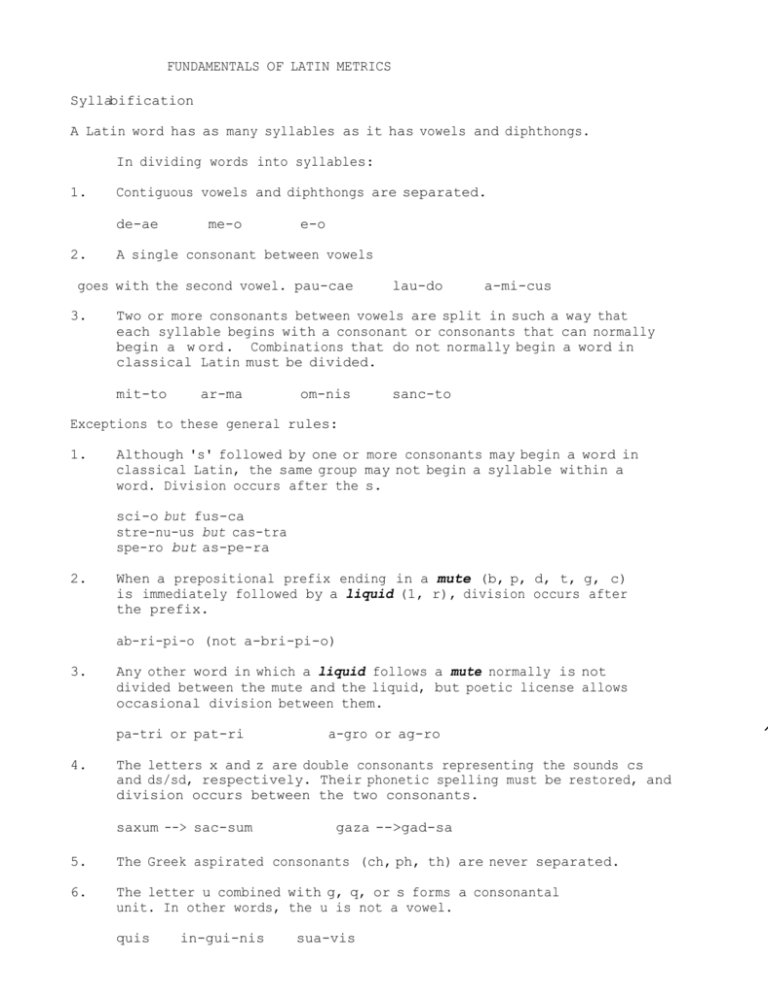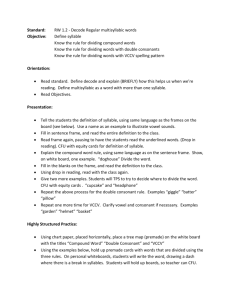Latin Metrics (Syllabification) handout
advertisement

FUNDAMENTALS OF LATIN METRICS Syllabification A Latin word has as many syllables as it has vowels and diphthongs. In dividing words into syllables: 1. Contiguous vowels and diphthongs are separated. de-ae 2. me-o e-o A single consonant between vowels goes with the second vowel. pau-cae 3. lau-do a-mi-cus Two or more consonants between vowels are split in such a way that each syllable begins with a consonant or consonants that can normally begin a w ord . Combinations that do not normally begin a word in classical Latin must be divided. mit-to ar-ma om-nis sanc-to Exceptions to these general rules: 1. Although 's' followed by one or more consonants may begin a word in classical Latin, the same group may not begin a syllable within a word. Division occurs after the s. sci-o but fus-ca stre-nu-us but cas-tra spe-ro but as-pe-ra 2. When a prepositional prefix ending in a mute (b, p, d, t, g, c) is immediately followed by a liquid (1, r), division occurs after the prefix. ab-ri-pi-o (not a-bri-pi-o) 3. Any other word in which a liquid follows a mute normally is not divided between the mute and the liquid, but poetic license allows occasional division between them. pa-tri or pat-ri 4. a-gro or ag-ro The letters x and z are double consonants representing the sounds cs and ds/sd, respectively. Their phonetic spelling must be restored, and division occurs between the two consonants. saxum --> sac-sum gaza -->gad-sa 5. The Greek aspirated consonants (ch, ph, th) are never separated. 6. The letter u combined with g, q, or s forms a consonantal unit. In other words, the u is not a vowel. quis in-gui-nis sua-vis / In spoken Latin, liaison occurs between the final syllable of one word and the initial syllable of the next word as follows: 1. If a word ends with a consonant (other than m) and is followed by a word beginning with a vowel (alone or preceded only by h), the final consonant is pronounced with the initial syllable of the next word. incipit Aeneas heros: “non ulla laborum” is pronounced as: in-ci-pi-tAe-ne-a-s(h)e-ros:"no-nul-la-la-bo-rum 2. Elision. If a word ends in a vowel (with or without m) and comes before a word beginning with a vowel (alone or preceded only by h), the final vowel of the first word is elided, or "struck out." men-sa e-rat men-se-rat pri-mum au-so-ni-is pri-mau-so-ni-is il-le hu-mi-lis il-lu-mi-lis The failure of elision to occur when all the conditions for elision are present is called hiatus. 3. Prodelision. When a word ending in a vowel (with or without m) precedes es or est (from esse), the e of es or est is elided. fe-mi-na es fe-mi-nas bo-num est bo-numst Quantity of Syllables A syllable is long if its vowel is long (macron or diphthong) or the syllable ends in a consonant. Otherwise, the syllable is short. Exceptions: 1. When hic (m. nom. sing.) and hoc (n. nom sing.) occur before a word beginning with a vowel (or a vowel preceded only by h), another c must be added to close the syllable and make it long. (h)ic-c a-li-e-nus (h)oc-c e-rat 2. When i appears between two vowels (in words such as aio, eius, maior, Gaius, Maia, and Troia), it is really a double consonant (jj). In scansion, the second consonantal i must be restored. ai-io ei-ius 3. A consonantal i must also be added in scansion for the compounds and derivatives of iacere (reicere, obicere, subicere, obex, etc.). ob-ii-ci-t il-le








